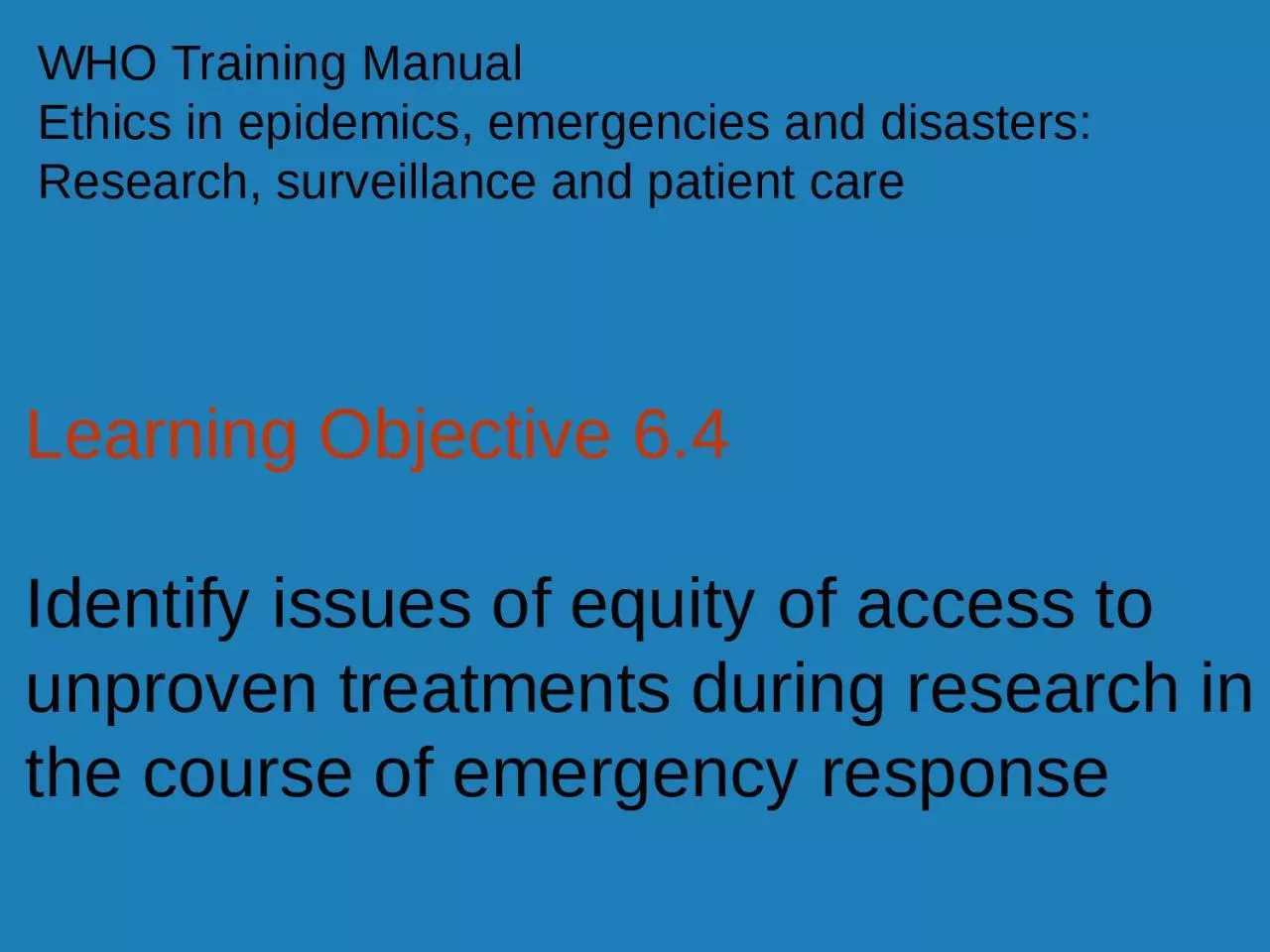

WHO Training Manual Ethics in epidemics emergencies and disasters Research surveillance and patient care Outline Introduction Case study filovirus hemorrhagic fever Debate ID: 915556
Download Presentation The PPT/PDF document "Learning Objective 6.4 Identify issues o..." is the property of its rightful owner. Permission is granted to download and print the materials on this web site for personal, non-commercial use only, and to display it on your personal computer provided you do not modify the materials and that you retain all copyright notices contained in the materials. By downloading content from our website, you accept the terms of this agreement.
Slide1
Learning Objective 6.4
Identify issues of equity of access to unproven treatments during research in the course of emergency response
WHO Training Manual
Ethics in
epidemics
, emergencies and
disasters
: Research, surveillance and patient care
Slide2OutlineIntroductionCase study – filovirus
hemorrhagic feverDebateConclusionTime (minutes)0-15(15 min)16-30(15 min)31-45(15 min)46-60(15 min)
Activity
Introduction
Reading
Debate
Summary and conclusion
Slide3What Resources Might Be Limited in a Public Health Emergency?Vaccines Medications to treat infected personsLife-sustaining medical technologies, such as ventilatorsHospital beds, particularly in intensive care
Laboratory capacity for diagnostic testsAccess to medical specialistsInfection control equipment
Slide4Novel treatments in emergenciesMay develop novel treatments/vaccines in public health emergencies, especially where epidemic is sporadicBenefit sharing normally requires that portion of benefit derived from collected data be returned to those whose data were usedBut in emergencies, benefits may not be so straightforward to distribute
Slide5Situations of limited access to novel agentsPhysicians using professional privilege and acting as gatekeepersSome patients unable/unwilling to enrol in research in spite of feeling they have a legitimate claim to the novel agent under investigationPhysical bottlenecks e.g. limited manufacturing capacity
Novel treatments not yet broadly accessible but at least relatively efficacious
Slide6Avenues to increase accessibilityDecrease regulatory restrictionsUse alternative research designsMultiple the ‘treatments’ under investigationAppeal to compassionate useEliminate physical bottlenecks
Determine minimal doseAppeal to the Rule of Rescue
Slide7Equity considerationsAccess limited to enrolled participantsRisk bearingConflicts of interest
Slide8Case studyOutbreaks of filovirus hemorrhagic fevers in central and west AfricaTuffs A. (2009). Trial vaccine may have saved Hamburg scientist from Ebola fever.
British Medical Journal, 388, b1223
Slide9Case study small group discussionsOn what moral grounds was the Hamburg scientist offered investigative treatment? Is this a case of compassionate use?Could ‘humanitarian’ reasons be put forward to justify the efforts of shipping the post-exposure vaccine from Canada? If yes, could reciprocity be one moral criterion (“The scientist made the sacrifice to risk her life by choosing to research on a highly lethal agent. In return, the community should make all effort to save her life in case of accidental exposure”)
When local health workers are exposed to needle stick injuries in the course of an Ebola outbreak in Africa, should they be given the same opportunities of a potentially life-saving treatment? Do the same moral grounds apply (e.g., “Are they any less or more worthy of reciprocity?”)?
Slide10Case study small group discussionsIf the investigative treatment is made available during and outbreak, should its use be restricted to the boundaries of a defined clinical trial? Or on compassionate grounds, like in the case of the Hamburg scientist?If a trial is the only acceptable solution, what should be the design of the trial? For example: consecutive series with historical comparisons, placebo controlled trial?
Ultimately, who are the main or intended beneficiaries of research on treatment for filovirus infection?
Slide11SummaryAlternative research designs may offer ways to deal with equity of access to novel drugs in epidemics and disastersMay be technical or moral concerns with these alternative designs e.g. informed consent where have lack of knowledge regarding risks of novel agentMust consider who will be the intended beneficiaries of research
Slide12SourcesTuffs A. (2009). Trial vaccine may have saved Hamburg scientist from Ebola fever. British Medical Journal, 388, b1223
Slide13AcknowledgementsChapter authorsCalain, Philippe, Médecins Sans Frontières, Geneva,
SwitzerlandBoulanger, Renaud F., Faculty of Medicine, McGill University, Montréal, Québec, Canada